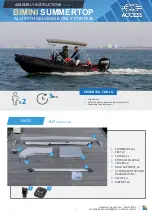
62
5) W przypadku obrotowych nóg podporowych, przekr
ęć
nogi w dół do pozycji pionowej i włó
ż
sworze
ń
blokuj
ą
cy
6) Przekr
ęć
d
ź
wigni
ę
zaworu na siłowniku podpory, aby
umo
ż
liwi
ć
przepływ oleju.
7) U
ż
ywaj
ą
c d
ź
wigni sterowania B (patrz §B.4.5, §B.4.6):
wysu
ń
siłownik do podło
ż
a tak, aby lekko unie
ść
samochód
jednak bez całkowitego odci
ąż
enia resorów.
8) Je
ż
eli to zrobione, przekr
ęć
zawór na siłowniku do
poło
ż
enia zamkni
ę
te. Kiedy siłownik nogi jest wysuni
ę
ty
sprawd
ź
czy samochód jest w poziomie (patrz §A.1.7).
9) Powtórz te same czynno
ś
ci dla pozostałych nóg
(patrz §B.4.5, §B.4.6).
Przekr
ęć
d
ź
wigni
ę
zaworu przeł
ą
czaj
ą
cego do czynno
ś
ci
ż
urawia.
Praca
ż
urawiem jest dozwolona tylko wtedy, gdy
podpory s
ą
rozło
ż
one prawidłowo.
5) In case of manual revolving stabilizer legs, move down
the legs into vertical position and insert the stabilizer lock
pin.
6) If present, turn the valve lever on the stabilizer cylinder
to allow oil to pass through.
7) Operate the control lever B (see §B.4.5, §B.4.6): the
cylinder must touch the ground and lift the truck slightly
without however fully releasing its suspensions.
8) If present, turn the lever of the valve on the stabilizer
onto the closed position. When all the stabilizer legs have
been positioned, check that the truck is level (see §A.1.7).
9) Repeat the same operations for the other stabilizing
points (see §B.4.5, §B.4.6)
Turn the lever of the deviation valve to activate the crane
controls.
Working with the crane is allowed only when the
stabilizers are arranged correctly.
A
B
C
D
















































